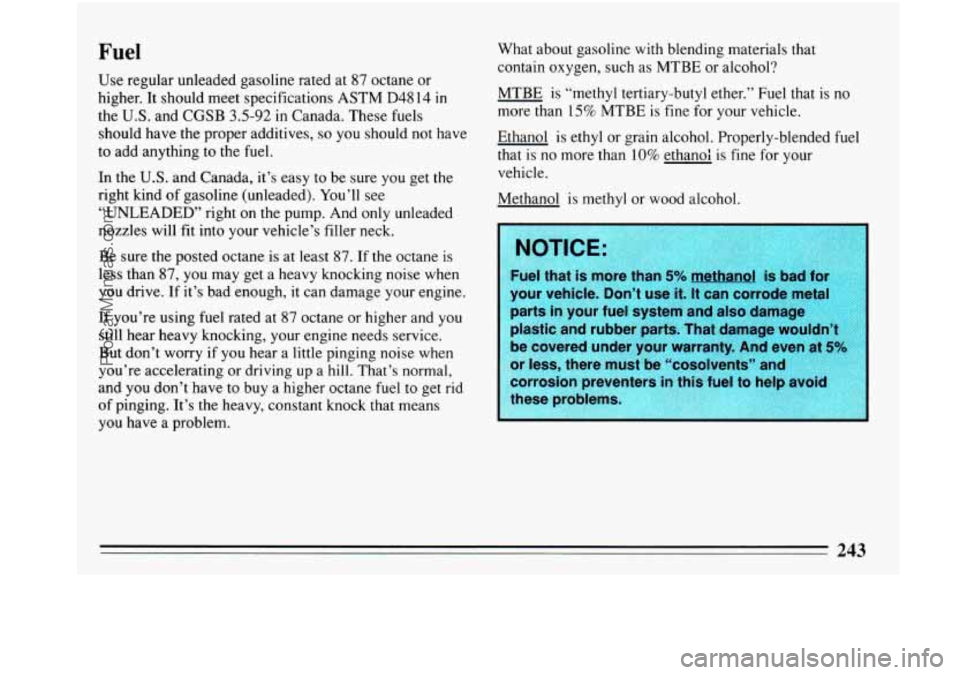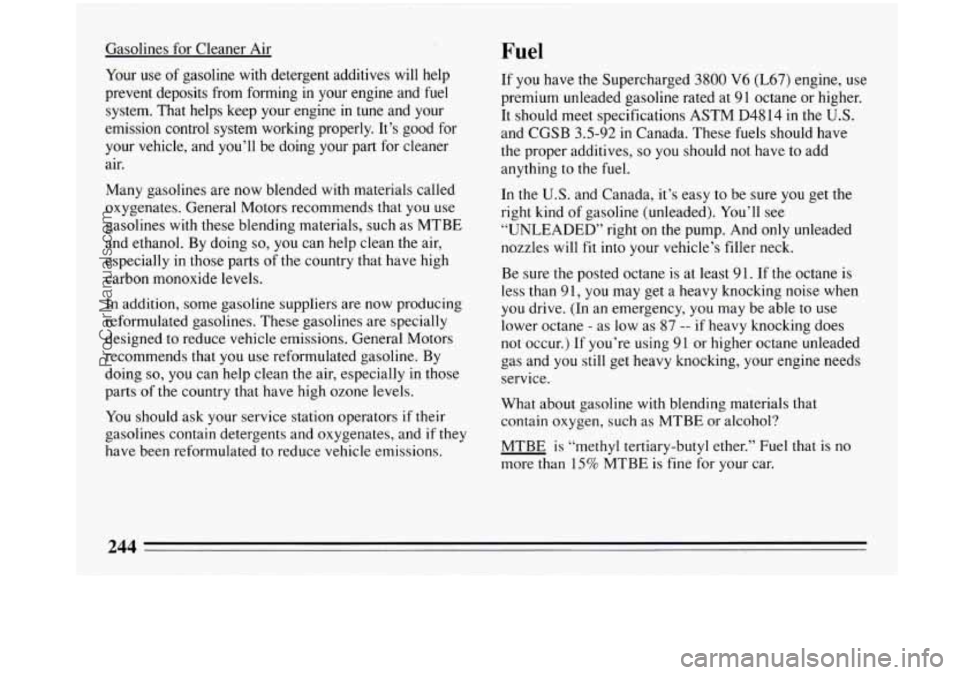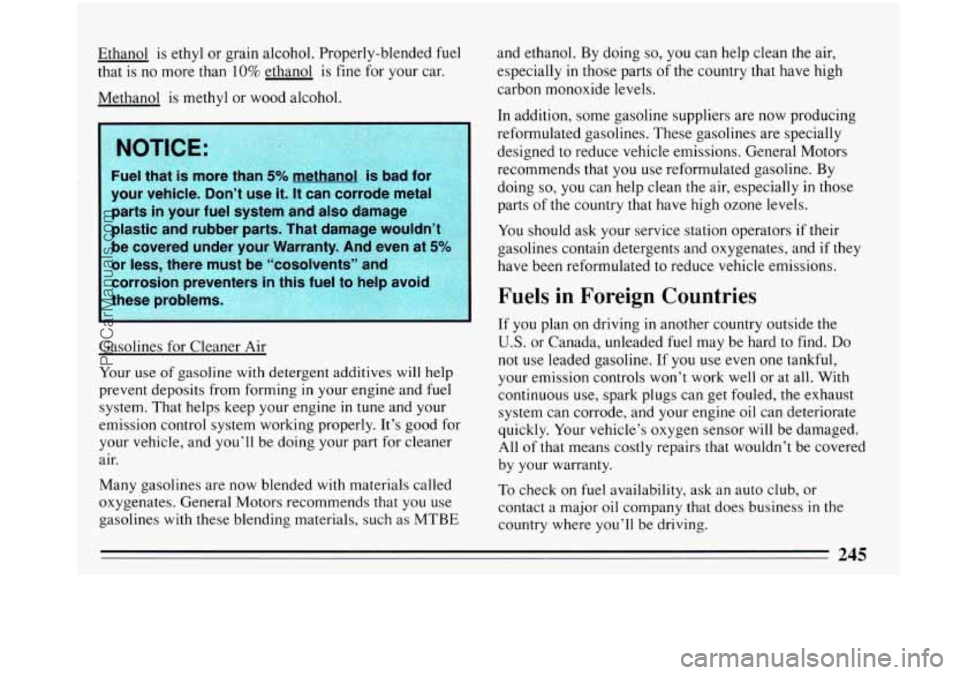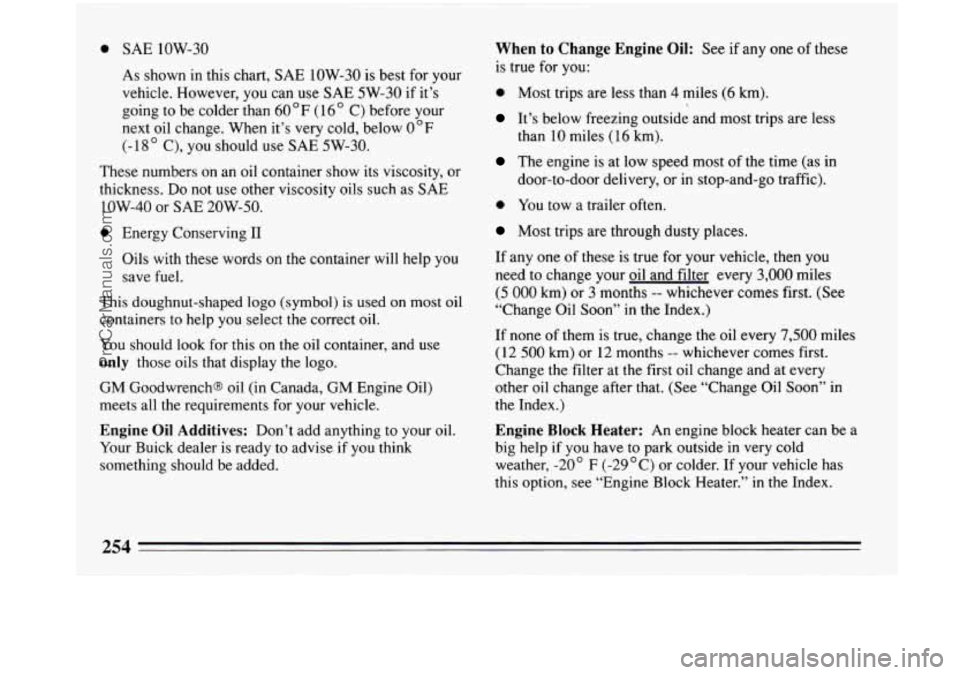fuel additives BUICK PARK AVENUE 1993 Owners Manual
[x] Cancel search | Manufacturer: BUICK, Model Year: 1993, Model line: PARK AVENUE, Model: BUICK PARK AVENUE 1993Pages: 340, PDF Size: 18.17 MB
Page 245 of 340

Fuel
Use regular unleaded gasoline rated at 87 octane or
higher. It should meet specifications ASTM D4814
in
the U.S. and CGSB 3.5-92 in Canada. These fuels
should have the proper additives,
so you should not have
to add anything to the fuel.
In the
U.S. and Canada, it’s easy to be sure you get the
right kind
of gasoline (unleaded). You’ll see
“UNLEADED” right
on the pump. And only unleaded
nozzles will fit into your vehicle’s filler neck.
Be sure the posted octane is at least
87. If the octane is
less than 87, you may get a heavy knocking noise when
you drive. If it’s bad enough, it can damage your engine.
If you’re using fuel rated at
87 octane or higher and you
still hear heavy knocking, your engine needs service.
But don’t worry
if you hear a little pinging noise when
you’re accelerating or driving up a
hill. That’s normal,
and you don’t have to buy a higher octane fuel to get rid
of pinging. It’s the heavy, constant knock that means
you have
a problem. What
about gasoline with blending materials that
contain oxygen, such as
MTBE or alcohol?
MTBE is “methyl tertiary-butyl ether.’’ Fuel that is no
more than
15% MTBE is fine for your vehicle.
Ethanol is ethyl or grain alcohol. Properly-blended
fuel
that is no more than 10% ethanol is fine for your
vehicle.
Methanol is methyl or wood alcohol.
Fuel that is more than 5% methanol is bad for
your vehicle. Don’t use it.
It can corrode me
parts in your fuel system and also damage
plastic and rubber parts. That damage woul
I
be covered under your warranty. And even at 5%
or less, there must be “cosolvents” and I
I
corrosion preventers in this fuel to
these problems.
ProCarManuals.com
Page 246 of 340

Gasolines for Cleaner Air
Your use of gasoline with detergent additives will help
prevent deposits from forming in your engine and fuel
system. That helps keep your engine in tune and your
emission control system working properly. It’s good for
your vehicle, and
you’ll be doing your part for cleaner
air.
Many gasolines are now blended with materials called
oxygenates. General Motors recommends that you use
gasolines with these blending materials, such as MTBE
and ethanol.
By doing so, you can help clean the air,
especially in those parts of the country that have high
carbon monoxide levels.
In addition, some gasoline suppliers are now producing
reformulated gasolines. These gasolines are specially
designed to reduce vehicle emissions. General Motors
recommends that you use reformulated gasoline. By
doing
so, you can help clean the air, especially in those
parts of the country that have high ozone levels.
You should ask your service station operators if their
gasolines contain detergents and oxygenates, and
if they
have been reformulated to reduce vehicle emissions.
Fuel
If you have the Supercharged 3800 V6 (L67) engine, use
premium unleaded gasoline rated at 91 octane or higher.
It should meet specifications ASTM D4814 in the
U.S.
and CGSB 3.5-92 in Canada. These fuels should have
the proper additives,
so you should not have to add
anything to the fuel.
In the
U.S. and Canada, it’s easy to be sure you get the
right kind of gasoline (unleaded). You’ll see
“UNLEADED” right on the pump. And only unleaded
nozzles will
fit into your vehicle’s filler neck.
Be sure the posted octane is at least 9
1. If the octane is
less than
9 1, you may get a heavy knocking noise when
you drive. (In an emergency,
you may be able to use
lower octane
- as low as 87 -- if heavy knocking does
not occur.)
If you’re using 91 or higher octane unleaded
gas and you still get heavy knocking, your engine needs
service.
What about gasoline with blending materials that
contain oxygen, such as MTBE or alcohol?
MTBE is “methyl tertiary-butyl ether.’’ Fuel that
is no
more than
15% MTBE is fine for your car.
ProCarManuals.com
Page 247 of 340

Ethanol is ethyl or grain alcohol. Properly-blended fuel
that is no more than
10% ethanol is fine for your car.
Methanol is methyl or wood alcohol.
Fuel that is more than 5% methanol is bad for
your vehicle. Don’t use it.
It can corrode metal
parts in your fuel system and also damage
plastic and rubber parts. That damage wouldn’t be covered under your Warranty. And even at
5%
or less, there must be “cosolvents” and
corrosion preventers in this fuel to help avoid
Gasolines for Cleaner Air
Your use
of gasoline with detergent additives will help
prevent deposits from forming
in your engine and fuel
system. That helps keep your engine in tune and your
emission control system working properly. It’s good for
your vehicle, and you’ll be doing your part for cleaner
air.
Many gasolines are now blended with materials called
oxygenates. General Motors recommends that you use
gasolines with these blending materials, such as MTBE and ethanol.
By doing
so, you can help clean the air,
especially
in those parts of the country that have high
carbon monoxide levels.
In addition, some gasoline suppliers are now producing
reformulated gasolines. These gasolines are specially
designed to reduce vehicle emissions. General Motors
recommends that you use reformulated gasoline. By
doing
so, you can help clean the air, especially in those
parts of the country that have high ozone levels.
You should ask your service station operators if their
gasolines contain detergents and oxygenates, and if they
have been reformulated to reduce vehicle emissions.
Fuels in
Foreign Countries
If you plan on driving in another country outside the
U.S. or Canada, unleaded fuel may be hard to find. Do
not use leaded gasoline. If you use even one tankful,
your emission controls won’t work well or at all. With
continuous use, spark plugs can get fouled,
the exhaust
system can corrode, and your engine oil can deteriorate
quickly. Your vehicle’s oxygen sensor will be damaged.
All
of that means costly repairs that wouldn’t be covered
by your warranty.
To check on fuel availability, ask an auto club, or
contact a major oil company that does business
in the
country where you’ll be driving.
245
ProCarManuals.com
Page 256 of 340

0 SAE low-30
As shown in this chart, SAE 1OW-30 is best for your
vehicle. However, you can use
SAE 5W-30 if it’s
going to be colder than
60 OF (1 6 ” C) before your
next oil change. When it’s very cold, below
0°F
(- 18 ” C), you should use SAE 5W-30.
These numbers on an oil container show
its viscosity, or
thickness. Do not use other viscosity oils such as SAE
low-40 or SAE 20W-50.
0 Energy Conserving I1
Oils with these words
on the container will help you
save
fuel.
This doughnut-shaped logo (symbol) is used on most oil
containers to help you select the correct oil.
You should look for this on
the oil container, and use
only those oils that display the logo.
GM Goodwrench@ oil (in Canada, GM Engine Oil)
meets all the requirements for your vehicle.
Engine Oil Additives: Don’t add anything to your oil.
Your Buick dealer is ready
to advise if you think
something should be added.
When to Change Engine Oil: See if any one of these
is true for
you:
0 Most trips are less than 4 miles (6 km).
It’s below freezing outside and most trips are less
The engine is at low speed most of the time (as in
door-to-door delivery, or in stop-and-go traffic).
0 You tow a trailer often.
than
10 miles
(16 km).
Most trips are through dusty places.
If any one of these is true for your vehicle, then
you
need to change your oil and filter every 3,000 miles
(5 000 km) or 3 months -- whichever comes first. (See
“Change Oil Soon” in the Index.)
If none of them is true, change the oil every 7,500 miles
(12 500 km) or 12 months -- whichever comes first.
Change
the filter at the first oil change and at every
other oil change after that. (See “Change
Oil Soon” in
the Index.)
Engine Block Heater: An engine block heater can be a
big help
if you have to park outside in very cold
weather,
-20” F (-29 “C) or colder. If your vehicle has
this option, see “Engine Block Heater.”
in the Index.
ProCarManuals.com